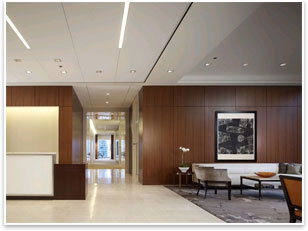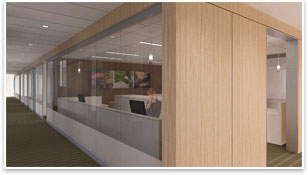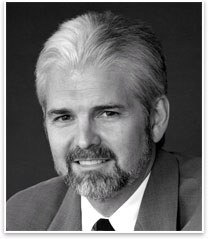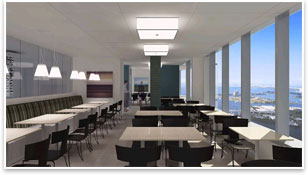Top Considerations for Today’s Law Firms
by Michael Considine and Michael Byun
Summary: The state of today’s economy affects our approach to conducting business in this ever-changing climate. Historically, management consulting firms have been on the leading edge of adapting to the evolving business environment and client demands, which have space-planning repercussions. To survive, many organizations have adopted the forward-thinking concepts developed by management consultants. Law firms are no exception.
The following trends highlight how law firms are adapting to changing client expectations and how these factors affect law office design.
1.Changing fee structures
As businesses operate more judiciously, retaining ongoing legal representation is becoming a thing of the past. To reduce legal costs, today's clients negotiate fixed fees for service. This change in revenue generation has forced law firms to examine their real estate expenditures and rethink how they work and use space.

This Chicago law firm has a dedicated conference center, designed by Perkins+Will, to welcome visitors and convey the firm’s desired image. Photo by Steve Hall © Hedrich Blessing.
The perception of how a law firm spends its money is another factor of change. Many law firms are opting to convey the image of an established, successful, yet fiscally prudent practice instead of the traditional perception of opulence. To accomplish this, they segregate the public areas from the balance of their facility. This affords them the opportunity to allocate money for a space that conveys the firm’s desired image, while controlling expenses within a clearly defined area. The focus for the remainder of the office is on constructing a cost-effective, efficient, and practical attorney environment.
2. Increase in specialization
Today’s clients seek "experts" to address their legal needs and are unwilling to pay to bring generalists or untrained attorneys up to speed on their specific needs.

Michael Byun IIDA, LEED-AP.
Intellectual property law, for example, is a growing field that requires a significant amount of knowledge relative to a specific industry. This particular practice seeks attorneys who have advanced degrees and experience in other fields. With these specialties come changing workplace requirements, which include varied collaboration styles, an increased use of technology, and alternate document management processes.
3. Need for “expert” leadership
As clients seek expert attorneys, the demand to have direct contact with a partner leading the effort has significantly increased. Clients expect greater accessibility to the people with the authority to make decisions on behalf of the firm.
Increased partner involvement has reduced the need for junior level attorneys, therefore impacting partner-to-associate ratios and, in turn, space requirements. Due to the nature of their work and ingrained cultural issues, partner offices are still larger than associate offices. It is likely that this trend will continue, due to the hierarchical symbolism of achievement that a larger office conveys. However, the changing partner-to-associate ratios continue to impact planning strategies.
4. Change in responsibilities
Many clients have become unwilling to pay for junior attorneys to perform many mundane document review tasks. In many cases, this work has since fallen upon less expensive legal support staff, such as paralegals, legal assistants, and research librarians.

Greenberg Traurig chose single-size “flex offices” to accommodate legal assistants, paralegals, and entry-level attorneys. Architectural rendering by Perkins+Will.
This shift has led to the need for improved workplace flexibility. One example is the development of single-size “flex offices” for the Miami offices of Greenberg Traurig. These 10’ X 10’ inboard offices offer a standard office configuration that can accommodate a legal assistant, paralegal, and first-year or summer associate level attorney. This arrangement allows the firm to adapt to staff requirements easily while minimizing workspace reconfiguration.
5. Outsourcing
Another trend is the use of contract attorneys to perform many of the tasks that typically fall to junior attorneys. This affords a firm the ability to adapt to client demands quickly while reducing labor and benefits management costs.

Michael Considine, LEED-AP, CID, IIDA.
This shift in resource utilization has given rise to many new issues regarding workplace needs and security. Contract attorney environments require less space, but demand greater document security and client confidentiality. Segregated support facilities such as copy rooms, case/file rooms, and personal storage lockers must be provided to aid in maintaining a high level of confidentiality.
6. Increased competition for talent
The competition for smart, experienced talent is still difficult, even in the current economy. The increased need for experts within a specific area of law has driven many firms to address recruiting and retention issues better.

Comfort and amenities are high priorities for Greenberg Traurig in Miami. Architectural rendering by Perkins+Will.
As individual workspace is reduced, firms need to attract and retain talent by improving the quality of the work environment by increasing access to technology, acknowledging an individual’s need for a work/life balance, addressing user-specific ergonomic requirements, and managing environmental issues such as natural light, temperature and lighting controls, and tenant amenities including access to after-hours/in-house food service and staff lounges.
7. Increased use of technology
The law firm industry is integrating the latest technologies to best support practices, giving attorneys the tools to work smarter and faster. The use of alternate means of remote access—WIFI, VPN, VOIP systems and video teleconferencing—continue to change how attorneys work. In support of these technologies, more robust computer networks and server space grow every year.
Changing fee structures, specialization, expert leadership, shifting responsibilities, outsourcing, competition for talent, and advancing technology will continue to drive changes to the practice of law and the future of law firm design.
|



